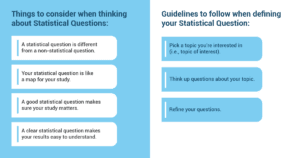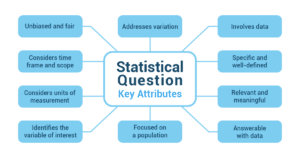Determining a proper research question is like setting sail on a grand adventure. It’s the compass that points us in the right direction, guiding our pursuit of knowledge and unveiling the secrets that lie hidden. Asking the right question is crucial because it shapes our entire journey, influencing the path we take and the answers we seek.
Like a compass guiding the way, a well-crafted question directs the researcher’s efforts, ensuring that the study’s objectives are clear and relevant. It serves as the foundation upon which data is collected, analyzed, and interpreted, influencing the choice of methodologies and guiding the researcher toward meaningful insights. A thoughtfully posed question allows for focused exploration, unveiling hidden patterns, exposing relationships, and advancing our understanding of the world. Conversely, a poorly formulated question can lead to ambiguity, wasted resources, and inconclusive results, leaving both researchers and society yearning for answers that remain frustratingly elusive. Thus, in the realm of statistical studies, the right question holds the key to unlocking the doors of knowledge and paving the way for impactful discoveries.
Crafting a Research Question
But here’s the thing: crafting a research question isn’t as simple as picking an item from a menu. It requires careful thought and consideration. It’s like solving a puzzle, where each piece contributes to the bigger picture. A well-crafted research question captures the essence of our curiosity, guiding us toward the heart of the matter.
- A statistical question is different from a non-statistical question
When we ask a statistical question, we’re not just looking for a simple answer. We want to study and understand how things vary within a group. Statistical questions involve analyzing data to find patterns, relationships, and differences. Unlike non-statistical questions, which often have straightforward answers, statistical questions require data to provide meaningful insights. - Your statistical question is like a map for your study
A well-designed statistical question acts as a roadmap for your study. It helps you plan what data you need to collect and guides you in analyzing and interpreting that data. By having a clear question, you can stay focused, organized, and achieve valuable results in your study. - A good statistical question makes sure your study matters
Choosing a statistical question that is important not only to you but also to others makes your study significant. By addressing meaningful questions, you contribute to knowledge and provide insights that are helpful and interesting to a broader audience. This way, your study has a real impact. - A clear statistical question makes your results easy to understand
When your statistical question is well-defined, it leads to clear and understandable results. By stating exactly what you want to find out, others can easily grasp and comprehend your findings. A clear question helps in effective communication and enhances the understanding of the implications of your research.
Guidelines for Defining Your Question
- Pick a topic you’re interested in (i.e., topic of interest)
Select a topic that sparks your curiosity and aligns with your areas of interest. A genuine interest in the subject matter will fuel your motivation and engagement throughout the research process. - Think up questions about your topic
Generate a list of questions related to your chosen topic. Begin with broad questions and then gradually narrow them down to those that can be answered using data. This iterative process allows you to refine and focus your research question. - Refine your questions
Evaluate your questions to ensure they are specific, important, and relevant to your study. Consider seeking feedback from peers, mentors, or subject experts to gain different perspectives and improve the clarity and quality of your questions.
Key Attributes that Make a Statistical Question Effective and Suitable for Research
- Addresses variation: A good statistical question focuses on understanding the variation within a population or between different groups. It seeks to explore patterns, differences, or relationships in data.
- Involves data: A statistical question requires the collection and analysis of data to find meaningful answers. It goes beyond subjective opinions or personal anecdotes and relies on empirical evidence.
- Specific and well-defined: A good statistical question is clear, concise, and well-defined. It leaves no room for ambiguity or confusion and provides a precise direction for the research study.
- Relevant and meaningful: The question should be relevant and have significance in the bigger picture. It should address a problem, fill a gap in knowledge, or help us understand something better.
- Answerable with data: A good statistical question can be answered by collecting and analyzing data. It’s possible to get the necessary information and draw valid conclusions. If you can’t collect the needed data, you may need to change your question.
- Focused on a population: The question specifies the group of people or things being studied. It narrows down the focus to make sure the findings are relevant to that specific group.
- Identifies the variable of interest: A good statistical question identifies the specific thing or characteristic being studied. It tells us what aspect of the group we want to measure, compare, or explore.
- Considers units of measurement: If the thing being studied can be measured with numbers, the question should say how that will be done. It tells us what units or scales will be used to measure it.
- Considers time frame and scope: The question thinks about the time period and place of the study. This helps set boundaries and gives context to the research.
- Unbiased and fair: A good statistical question doesn’t favor one answer over another. It allows for fair and impartial analysis. It considers all possibilities and perspectives.
How to Avoid Mistakes and Make the Best Research Questions for Your Statistical Investigation
- No fuzzy questions: It’s important to avoid fuzzy or unclear questions that make it difficult to gather the necessary data or decide how to analyze it. Make sure your research question is detailed and provides a clear direction for your study.
○ Fuzzy question: “What do employees think about the company?”
○ Non-fuzzy question: “What is the overall satisfaction level of employees regarding the company’s “out-of-office” activities?”
In this revised version, the question specifies the target group (employees), the aspect of the company (“out-of-office” activities), and the information sought (overall satisfaction level). This makes the question clearer and provides a specific focus for data collection and analysis. - Do not forget about variation: A good statistical question looks closely at how things are different, related, or connected within a group of people or things. It wants to find patterns or differences that can be discovered by studying data. If researchers don’t pay attention to these differences, they might ask questions that are too general and miss important details. This can make the results unfair or not complete, which makes the study less reliable and helpful.
- Question without variation: “What is the temperature?”
- Question with variation: “How does the temperature vary throughout the year in different regions of the world?”
- Think of many questions: Do not settle for the first question that comes to mind. Think of multiple questions related to your topic and explore various angles. By considering multiple perspectives, you can select the most promising research question for your investigation.
- Ensure fairness (avoid bias): Try to avoid asking questions that could make you prefer a certain answer or viewpoint. It’s important to stay fair and objective in your research question so you can consider all the different possibilities. This helps you analyze the data in a complete and unbiased way without any favoritism.
○ Biased question: “Do you agree that smartphones are ruining the younger generation?”
○ Fair question: “What are the effects of smartphone usage on the younger generation?”
The original question seems to have a biased view against smartphones and assumes they have a bad influence on young people. It may influence people to answer in a specific way. The revised question, on the other hand, removes the bias by asking about the effects of smartphone usage without assuming they are negative. This lets us explore both the good and bad effects and consider different opinions. We can then look at various outcomes, like how smartphones affect social interactions, company performance, mental health, and overall well-being. This approach allows us to have a fair analysis without any preconceived ideas.
Exploring the Impact of Lighting Techniques on Portrait Photography
In the ever-evolving world of photography, Rachel Turner, a seasoned corporate professional and avid photographer, found herself driven by a burning curiosity. Her journey began with a simple yet thought-provoking research question that would open doors to deeper insights in her passion – photography.
Rachel had always been captivated by the artistry of portrait photography. She was fascinated by how lighting techniques could dramatically transform the mood, emotions, and even the personality of a subject. Drawing from her corporate experience in marketing, she understood the power of visual communication and wondered: “How do different lighting techniques impact the perception of subjects in portrait photography?”
Rachel’s inquiry was grounded in a desire to explore the relationship between lighting and perception in portrait photography. As a photographer herself, she was no stranger to the pivotal role lighting played in crafting an image’s narrative. With her corporate acumen, she recognized that understanding the psychological impact of various lighting techniques could have broader implications in fields like advertising and visual storytelling. Driven by her research question, Rachel embarked on a journey of exploration. She knew that her inquiry would require a blend of artistic intuition, technical expertise, and a robust understanding of psychological nuances. Armed with her camera and a research mindset, she set out to design a study that would shed light on the interplay between lighting techniques and human perception.
Rachel’s study was meticulously designed to encompass both technical and subjective aspects. She planned to photograph the same subject using different lighting techniques – soft, diffused light for one set and harsh, directional light for another. She would then present the resulting images to a diverse group of viewers and gather their impressions and emotional responses. Drawing parallels from her corporate project management skills, Rachel executed her study flawlessly. She photographed her subject using controlled lighting conditions, carefully adjusting camera settings to maintain consistency. She then collated the feedback from her diverse group of viewers, ranging from photography enthusiasts to individuals with no photography background. Drawing from her marketing expertise, she employed sentiment analysis techniques to extract qualitative data and insights from their responses.
As the data rolled in, Rachel applied her analytical prowess to interpret the findings. She discovered that soft, diffused lighting evoked feelings of warmth, approachability, and intimacy. In contrast, harsh, directional lighting conveyed strength, drama, and perhaps an air of mystery. Her analysis illuminated the psychology behind the visual impact of lighting techniques in portrait photography, offering a fresh perspective on how images could be crafted for different emotional and narrative purposes.
Rachel’s research question, rooted in her corporate experience and love for photography, opened new avenues for understanding the convergence of art and psychology. Her case study underscores how a single inquiry can lead to multifaceted insights with implications for industries far beyond the realm of photography. It’s a testament to how a corporate professional’s curiosity can spark meaningful research that bridges disciplines and enriches our understanding of the visual world.

